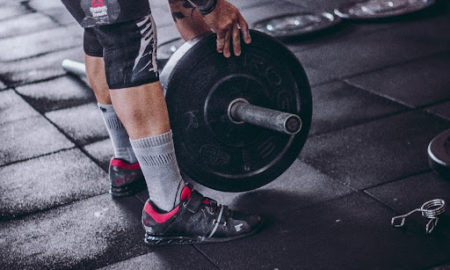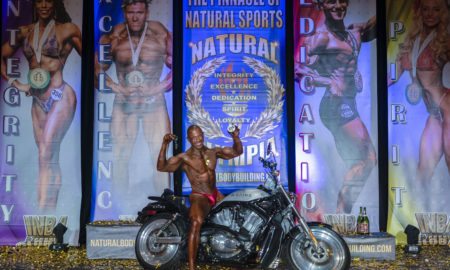What would you say if I suggested that the most cutting-edge training theories in bodybuilding may belong to a 51-year-old IFBB pro who’s been lifting for 26 years and is approaching his next competition, the ’09 Atlantic City Pro, with a goal of making the top 15? That I’m crazy? Well, I may have been spending too much time at the computer lately, but I’m pretty sure I’m not crazy—although getting this type of response during a bodypart-training interview will drive a writer a little nutso:
CC: So, what’s your chest routine?
LA: I don’t have a set routine.
My first thought? “Awww crap.” After that I contemplated the children’s book I wanted to write—or maybe the next great American novel. Then it hit me: This is something entirely different from what anyone else is doing, and it’s being done by a veteran of the iron game who’s competing against men half his age. Lee Apperson’s philosophy regarding weight training is to constantly move forward, to never be satisfied with the status quo. He believes that it’s folly to go back to where you were, that a routine is limiting in and of itself.
“Everything is part of a big puzzle,” he says. “How you put the puzzle together decides whether or not you’ll be successful.” It’s chest training without a net, always finding new ways to pound the muscles into submission, to stimulate them from new angles, with more weight, creating a balance and flow that many feel are missing from the bodybuilding stage today.
Lee readily admits to being a throwback to a bygone age when bodybuilding contests also involved feats of athleticism and people on the beach were building muscles and engaging in sport, wanting to look both good and athletic at the same time. He is so out of the norm from the modern physique standard that it appears at times that the judges don’t quite know what they’re supposed to do with him. When you think about it, it makes sense.
Bodybuilders from the so-called golden age of bodybuilding were physical culture Renaissance men. They possessed a lithe, streamlined look that would be considered not thick enough compared to today’s behemoths. The physiques more closely resembled ancient Greek statues than comic book drawings, and athletic prowess was valued above mass. Some would call the modern look progress; others would disagree. The wonderful thing about bodybuilding is that there’s no right or wrong answer, only opinion. Unless you’re in a competition, that is. In that case there is a “right” opinion—the opinion of the judges.
“I wish they’d bring back the masters shows,” says Lee. “It’s harder to prepare for a contest when you know you’re competing for 15th place.”
In masters events Apperson is very competitive. At the ’08 Atlantic City Pro, where there was a masters contest, he finished second in the over-50 category. In masters events held from 1999 to 2003, he finished ninth, 11th, eighth, 14th and 15th. When he competes against the “boys,” he’s a little less successful. From 2004 to 2007—when there were no masters shows—Lee entered four competitions, placing outside of the top 15 every time.
Earlier in his career Lee was one of the top amateur bodybuilders in the country, winning the AAU Mr. America title in ’94 and ’95, the NABBA Mr. USA in ’96 and the NPC Masters Nationals in ’98, when he earned his IFBB pro card. Lee also finished in the top 10 at the NABBA Mr. Universe in ’97 and ’98, just before he turned pro.
So what keeps a guy who’s used to getting the good callouts going when he’s relegated to the last ones? The process.
“There are a lot of ways to stay in this game,” Lee suggests. “There’s photography and writing, commentary and personal training, but I’m trying to forestall all of that for as long as I can.”
There’s also the faint hope that masters shows will come back into vogue. Should that happen, Lee feels that he’ll have a built-in advantage over the other competitors because he’s stayed in the game while everyone else has been away from the grind of contest prep.
Then there’s the small fact that he loves the competition, loves the prep and lifting, loves going through the process of getting ready for a show, meeting fans along the way and knowing that he’s put forth his best effort.
If there’s a word that best describes Lee Apperson’s chest training, it’s different. He strives to hit the chest from different angles every week. There’s nothing so out there that Lee won’t try it at least once. If it works, he’ll keep tweaking it and adapting it to his program.
“The only thing I don’t do in my chest training is flat-bench presses with a barbell,” he reveals. His reason has to do with injury concerns.
“At 50 I can’t do some of the things I was doing at 20 or even at 40. You have to be conscious of that and keep yourself healthy.”
In other words, it’s hard to build muscle when you’re in a sling or recovering from surgery. Beyond that, Lee’s chest training is a mish-mash of machines, free weights, isometrics—you name it.
“I’m constantly working on finding new ways to use a machine,” he says. Currently, Hammer Strength machines and dumbbells are two of his favorite tools.
When pressed on the dumbbell question, Lee confides that he prefers using them to a straight bar because they are “the ultimate free weights.” His training philosophy is built around developing muscle while maintaining a balanced physique. Using dumbbells gives him a greater range of motion, brings the stabilizing muscles into play and provides greater control while he’s pounding the target muscle into submission.
Another point he makes is that newer doesn’t always equate to better. Lee’s evaluation of equipment can be summed up as follows: “Was the guy who invented it smart in the 1950s? Was the guy who invented it smart today? All I care about is whether the machine in question properly works the muscle. Hearing a guy say, ‘Oh, they have new equipment,’ is useless. The real question is, Does a gym have equipment that works?”
Speaking with Lee Apperson is like getting a chance to speak with bodybuilders of the ’50s and ’60s. Its refreshing to do a chest-training interview that’s something more than just a rehash of the benefits of compound vs. isolation movements and pounding away at free weights until your pectorals quiver.
To most of us bodybuilding is about much more than that. Bodybuilding is an important part of our daily lives. For Lee Apperson it’s much the same—he’s just more accomplished at it than we are.
Editor’s note: Lee Apperson is an IFBB pro based in Florida. To contact him for guest posing, training or sponsorship, visit him at www.LeeApperson.com. IM
Lee Apperson’s Sample Chest Programs
Week 1
Incline barbell presses
2 x 30 x 135
1 x 10 x 185
2 x 8 x 275
Cable crossovers (clavicle level)
1 x 20 x 50
1 x 15 x 70
1 x 10 x 120
Dumbbell bench presses
2 x 20 x 60s
1 x 15 x 90s
1 x 10 x 120s
Week 2
Hammer Strength flat-bench
presses (not upright type)
1 x 20 x 225
1 x 12 x 315
1 x 10 x 405
Incline dumbbell presses
1 x 15 x 70s
1 x 12 x 90s
1 x 10 x 110s
Pec deck flyes 1 x 15 x 100
1 x 12 x 180
1 x 10 x 220
Week 3
Cable crossovers (at floor level; don’t raise handles higher than top of abs)
1 x 20 x 70
1 x 15 x 80
1 x 10 x 100
Pushups (handles on floor, feet on bench)
1 x 15 x bodyweight
1 x 12 x 45
Hammer Strength incline
presses 1 x 20 x 225
1 x 12 x 315
1 x 10 x 405
















You must be logged in to post a comment Login